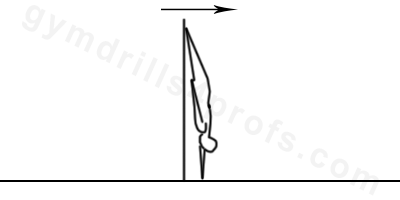


A handstand full pirouette is divided into two identical half turns. Each half turn should be done through two-quarter turns. The gymnast turns around the base arm with one quarter turn. Then they should switch the arms and have the other arm perform another quarter turn. Then the gymnast repeats the same move, concluding the full turn. There are several modifications of the turns (rotations). In the first one, the gymnast does an entire half turn with one hand motion. Then performs the second turn in the same way. This is useful for teaching a pirouette on single rail events like high bar and uneven bars. The second modification involves the gymnast performing two quarter turns during each half of the full rotation. This is useful in teaching the gymnast more control during their handstand, and for teaching a pirouette on parallel bars, where half turns with one hand motion are not possible. The half turn could be performed vice versa too - in the first quarter the arm moves backward, and during the second quarter, (in opposite), the second arm is moving forward. During the execution, the body should be entirely straight. A common mistake involves the gymnast breaking the body position from the hips.

A handstand involves holding a tight body position in an inverted vertical position, balancing on one’s hands. The most basic form of a handstand involves the arms and legs being completely straight. The feet should remain together, while the hands should be roughly shoulder width apart. This makes balancing easiest when remaining in a stationary position (no walking). During the handstand, the butt and core should be tight, and the head should be in a neutral position, with the eyes watching the hands. It’s very important not to watch the hands with the head back, as this can lead to arching through the entire back. The shoulder angle should be completely straight, and the body should be stretched. As the handstand improves, more difficult modifications of the skill can be performed.

The handstand on one arm could be done with assistance, or against a wall. The scope of the drill is to keep the body line exactly straight.

When the gymnast masters the body position of a handstand and one arm handstand, they should begin doing half turns in a handstand. The same rules apply - keep the body position straight at all times.

When the gymnast acquires enough experience, they should aim to perform the entire skill (a full pirouette). During the first attempts, a spot is recommended. This helps the gymnast to focus on maintaining a proper body position and precise steps with their arms.
Integral part of gymnastics coaching process are skill drills. They help gymnasts to learn easier and technically correct. With GYM DRILL PRO you will find variety of ideas for the most the basic gymnastics skills. There are plenty of images with skill drill progressions. It is intended to support explicitly the qualified coaches in their daily coaching business. DO NOT practice without the guidance of proper professionals.